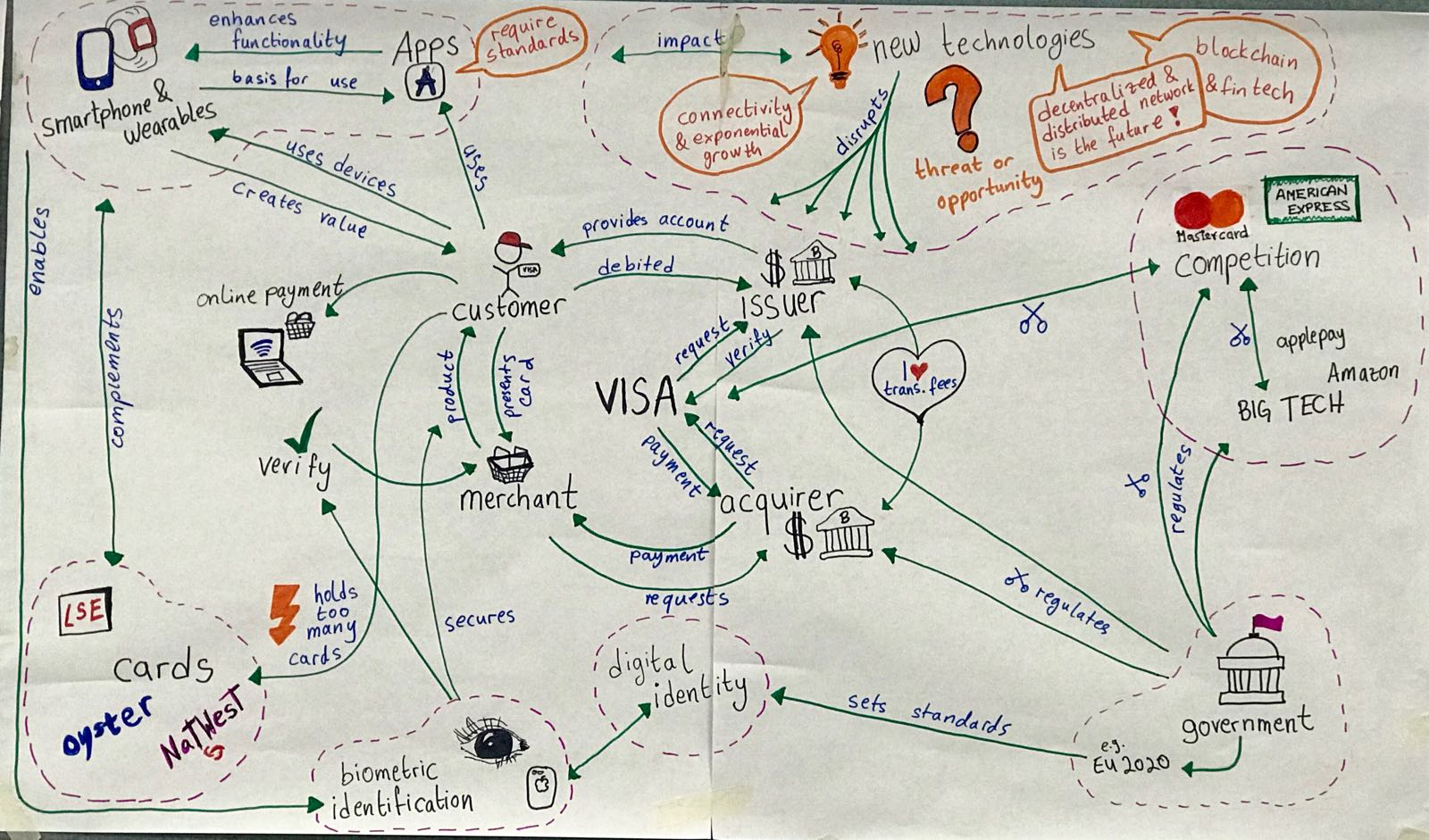On this last day of term I thought I would take a moment to reflect on the online teaching of “Innovating Organisational Information Technology” at the LSE with Carsten Sorensen and, in particular, the hugely popular LSE Sprint Week; a week long sprint following Jake Knapp’s influential sprint book which I organise and run.

Usually this involves ~100 students working together in a huge hall around tables and whiteboards (see left). But this year, with only a couple of weeks notice, I had to move this entirely online. 110+ students, 21 parallel Sprints, various technical and administrative challenges, a real-world business problem, and world-class consultants judging on Friday afternoon. All online.
The week starts with a presentation from VISA of a significant challenge our students must address: this year it was various scenarios of fraud using the fast-payment infrastructure. Having received the challenge I released the my pre-prepared MURAL.co templates for each group to follow. The templates set out exactly what each group needed to do each day and were vital to ensuring groups could self-manage the week. Mural is a whiteboarding solution allowing you to zoom right into tiny post-it notes or images (see below). The groups would then use the templates adding their work collaboratively during the week and submitting their design via the red box on Fridays template. The template contain everything the groups needed including templates, instructions and forms.

The template was thus designed to be followed without outside facilitation by faculty and with each student in each group taking the role of group-facilitator for one of the days. In addition, dice were thrown to see who would be the “Decider” in the group – the group-CEO who could be called upon to make any tricky decision. Dice work well for this – ensuring the role is not always allocated to the loudest and most confident in the group.
One useful feature of MURAL is the ability to create rooms for shared collaboration around whiteboards. I therefore created seven rooms and clustered the groups into these allowing them to each see two other groups Mural-whiteboards. Clusters allowed groups to compare, discuss and peer-review each others work, and reduced the stress on groups as they could see how two other groups were struggling or overcoming the challenges and ask them questions. It also increased drastically social interaction among students. Each day Carsten and I met with each cluster for 30minutes – providing feedback and answering questions. This was important as it allows us to review each group quickly and maximise the time we had. Zoom was used for these meetings. We also held short “All-Hands” meetings every morning to share learning with the whole 110 students.
Outside speakers are major part of the Sprint Week and we were delighted to have Jake Knapp himself join us on two days to present and answer questions. This proved important as it reinforced that, despite not having a face to face sprint week, this was just as intense, innovative and important an experience for our students. This message was reinforced by VISA’s innovation team who have used Mural.co all this year, and by Roland Berger’s Spielfeld Digital Hub GmbH team who joined later in the week. Thanks to sponsorship from Roland Berger we could provide students with a copy of the book as well! [Jake is 4 along, 2, down, myself 2,1, Carsten 4,1].

Jake proved amazing at lightening the mood and helping the students realise that online sprints are certainly possible, and can easily be useful, innovative and fun – reinforced by organising a zoom dance session.

Scheduling
With so many moving parts during the week scheduling was vital. Outlook calendar proved the best tool available for this. Sharing my calendar with my admin support, and sending meeting invitations to all the students, either on-mass or in their clusters, allowed us to schedule the whole week. This also allowed dynamic changes during the week to be shared quickly with everyone and, crucially, handled time-zone challenges for those working overseas (though many of these students had decided to shift their body-clock for the week and so worked nights). Below is the final schedule for the week. Notice that during Wednesday and Thursday we had sessions where Roland Berger consultants mentored each group. This consultant feedback, (including from some who were our Alumni), was vital as it give industry-relevant feedback and reassured groups that the skills they were gaining were relevant to industry today! Finally we bought a cheap mobile phone and through this provided a WhatsApp, WeChat, Voice and Email helpdesk (manned by Dr Boyi Li) throughout the week.

Evaluation
During a face-to-face sprint it is easy to gauge the mood of the teams and adjust the week accordingly – indeed this is one of the key skills of a facilitator. But for twenty-one online parallel groups this was impossible. As such I devised a daily “check-in” form using Microsoft Forms which each student needed to complete nightly and which I reviewed each morning. This was helpful in showing minor points for improvement, and also extremely satisfying to see the overall rating for the the week:


Marking:
The students received two forms of feedback for Sprint Week. The first was on Friday when I invited industry experts (from Visa and Roland Berger, PA Consulting, Government and Salesforce) to form a “Dragon’s Den” to watch the video pitches each group had prepared and judge the winners based on innovativeness of the pitch. This was a wonderful experience for groups and unveiled the “winners” of sprint week – who will go forward to present their ideas to VISA’s innovation labs next year.
This was not however the judgement of academic success, and after Sprint Week Carsten and I carefully marked each groups project based on the following criteria (listed on each groups MURAL) for their academic grade:

Having an academic grade for Sprint Week has been important in ensuring groups feel the stress of caring about their design. Each group then received a feedback form with a few paragraphs explaining the rational for the marks and outlining any limitations in their design – thus ensuring they learnt from the entire experience.
Teamwork support
Before the week started teams were encouraged to organise a meeting and use the Team Canvas to understand their working practices and plan the week. I also held a 1hr introduction to Mural so the students would know how to use the tool effectively prior to Sprint Week.

Video Conferencing equipment:
Finally I was also lucky enough to have very good quality equipment to run Sprint Week . I used an ATEM Mini Pro video switcher and my own good camera and microphones for meetings. These tools proved invaluable during the teaching as, within zoom calls, I could add overlays with information (e.g. lower-third messages about the day) and professionally switch between devices (e.g. my video camera, an overhead camera for drawing/whiteboarding, images, my tablet as a white-board, even my phone to show a Time Timer app). During meetings for example I could put my phone as a timer in the corner of my Zoom video images to keep students to time. This technology, while expensive and complex to use, improved the professionalism of my teaching this term and, perhaps, along with the work above, helped reassured students that they were still receiving an LSE quality sprint experience online.




 Martin Kasseth, 2017-18 MISDI student from Norway:
Martin Kasseth, 2017-18 MISDI student from Norway:


